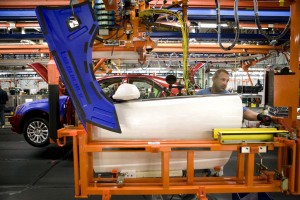
GM will invest $190 million at the Cadillac plant, in Lansing, Michigan, to launch production of a new small luxury car.
All signs point towards the upcoming General Motors IPO, but the planned General Motors stock offering remains shrouded in secrecy.
Though GM announced plans to reduce its debt by $11 billion on Wednesday (Click Here for more) chief executive Dan Akerson pointedly ducked questions on speculation GM will wrap up its initial public offering of stock by mid-November.
Akerson remained “on message,” as his public relations handlers might have described it, focusing on the announcement of a new Cadillac model and refusing to talk not only about the IPO but also about GM’s third quarter financial report.
Nonetheless, the maker’s anticipated July – September profit, which would be its third quarterly earnings report to show black ink, is widely anticipated to be the finally piece of the jigsaw puzzle that will trigger GM’s long-awaited return as a publicly-traded company.
Former Obama administration auto czar Steve Rattner, in the midst of a tour to promote his book on last year’s GM and Chrysler bailouts, said recently that he expects GM to launch the IPO on November 17.
“I’m not going to comment on the IPO,” said Akerson, while surrounded by reporters following the announcement GM plans to spend $190 million for new tooling and equipment for a new small car project at the Grand River Assembly plant in Lansing, Michigan.
(The executive and other GM officials remained circumspect about that project, as well, though TheDetroitBureau.com reports the new model, tentatively dubbed the ATS, will slot below the current Cadillac CTS and target such established luxury competitors as the BMW 3-Series. (For More, Click Here.)
Akerson said the investment at Grand River should bolster Cadillac sales.
“It’s a good thing because it will expand Cadillac’s footprint in the market,” said Akerson, who took over from Ed Whitacre on Sept.1.
“America’s fastest-growing luxury brand this year is about to get even more competitive with the addition of an all-new luxury car,” said Akerson, who spent most of career in telecommunication before GM’s board in 2009.
The Grand River plant now builds Cadillac’s CTS, CTS Coupe and STS models and is one of the few GM plants that exports vehicles to Europe, China and the Middle East.
Akerson said he was impressed with both the efficiency of the Lansing plant and the enthusiasm of the workers.
Bob King, the new president of the United Auto Workers Union, said he hoped the IPO will relieve the financial pressures on the Voluntary Employee Beneficiary Association, which took over responsibility for the health-care of GM’s retired hourly workers.
“We think it’s a good thing. We think it will help,” he said, following the official announcement of GM’s Lansing’s investment.
Industry observers have been worried about the viability of the various industry VEBAs, which were established by each of the Detroit Big Three as part of their negotiations with the UAW in 2007. But there are signs the health care programs are finding more solid ground.
As part of its plan to reduce debt, GM will repay $2.8 billion to its VEBA. Meanwhile, Ford this week announced it would contribute $3.6 billion in cash to its health care trust, leaving it fully funded for the first time ever.
King declined to comment directly on IPO-related issues such as timing or price.
However, the union boss insisted that both the IPO and GM’s decision to bring back a second shift and add 600 jobs at the Grand River plant vindicate the union’s decision to make concessions needed to help bring GM back from bankruptcy.
“We did it to save GM,” King said.
